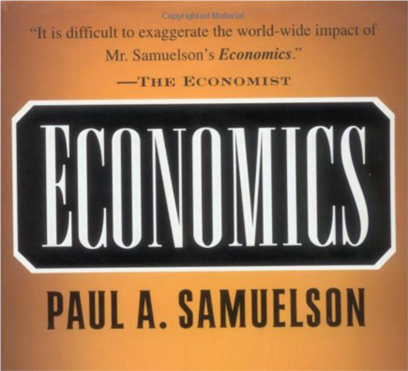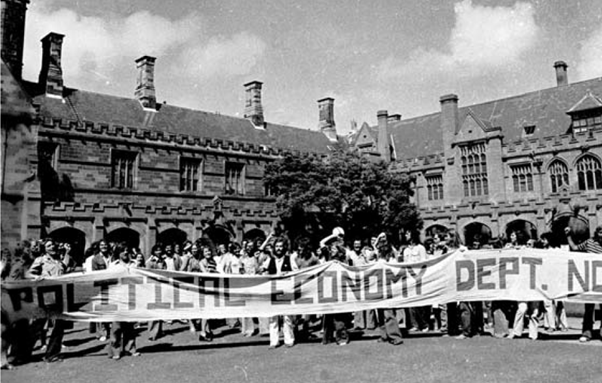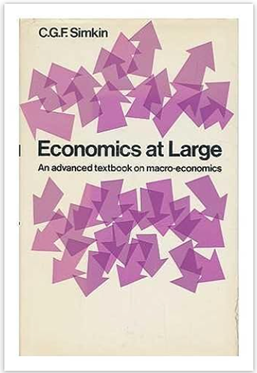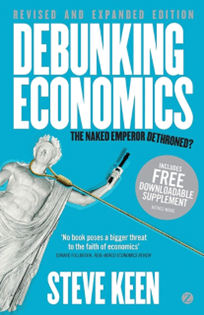“Poets are the unacknowledged legislators of the World.” It was a poet who said that, exercising occupational license. Some sage, it may have been I, declared in similar vein: “I don’t care who writes a nation’s laws—or crafts its advanced treaties—if I can write its economic textbooks.” The first lick is the privileged one, impinging on the beginner’s tabula rasa at its most impressionable state.
The opening paragraph in Paul Samuelson’s Foreword to The Principles of economics course: a handbook for instructors (Saunders and Walstad 1990, p. ix)
We hear a lot (as in far too much) about and from Larry Summers these days, but in the good old days, Summers was more famous for being Paul Samuelson‘s nephew than he was for being himself.
Samuelson, and not Keynes, was the true father of what became known as “Keynesian economics”. Samuelson developed what came to be known as the “Keynesian-Neoclassical synthesis” in his PhD thesis (Samuelson 1947). His textbook—initially called Economics: An Introductory Analysis (Samuelson 1948), later simplified to just Economics (Samuelson and Nordhaus 2010)—presented a palatable version of this thesis as an introductory textbook for students of economics in the post-WWII world. It quickly became the dominant economics textbook on the planet, and everything that has happened in economics since can be traced back to it.

Samuelson’s impact on the development of economic theory was so profound that he was the first sole recipient of the “Sveriges Riksbank Prize in Economic Sciences in Memory of Alfred Nobel“, in its second year of 1970. That was also the year that an Australian edition of his textbook was published, and adopted as a textbook by the Economics Department at the University of Sydney, where I began my undergraduate degree in 1971.
Two years later, in March 1973, Samuelson came to Sydney. This was big news at the time: “it was the first time an economics Nobel Prize winner had graced Australian shores”, Alex Millmow noted, and “Samuelson’s arrival made front page news in Australia’s business daily The Australian Financial Review (AFR)” (Millmow 2019).
Samuelson’s formal reason for the visit was to promote the Fulbright Scholarship scheme, but he also agreed to give a seminar at the University of Sydney—but not to the students. It was to be a staff-only seminar.
By this stage, I was an implacable critic of the entire Neoclassical edifice that Samuelson had created, and many of the academic staff felt the same way. They let me and a fellow student rebel, Richard Fields, know of the planned staff-only seminar, and we decided to prank it. I think Richard came up with the idea that we should put up posters announcing that Paul Samuelson would give a lecture in Merewether 1—the main lecture theatre in the Economics faculty building—at precisely the same time as his scheduled staff-only seminar. We’d publicity-shame them to move the seminar into the public arena.
Our ruse worked. At the appointed hour on March 22nd 1973, the conservative staff in the department duly rolled into a lecture theatre that had about 150 students and some progressive staff already in attendance. They sat in the front two rows while Samuelson, ever the showman as well as the intellectual, explained that he was going to give us the talk he’d give “if my grandmother asked, what’s this ‘General Equilibrium’ thing?”.
The blackboards filled up with masses of equations, and then Samuelson got even with a prank of his own—though it was at the expense of the conservative staff, rather than us.
I was sitting about halfway back in the lecture theatre, next to Tony Phipps, the quantitative methods lecturer in the department. Tony was a great bloke: everyone liked him regardless of politics, and he didn’t take sides in the then very antagonistic arguments between the Neoclassical and anti-Neoclassical staff. We were sitting together to help each other follow the mathematics.
We were doing well until at one point, Samuelson made what appeared to both of us to be a simple error: putting a plus sign where he should have put a minus. One of us leaned over to the other—I can’t remember whether it was Tony to me or vice versa—and said, “Shouldn’t that have been a minus?”. “Yeah, I think”, the other replied, “but this is Samuelson”. I didn’t have the courage to put my hand up and query the maestro (even if I didn’t like his music), and neither did Tony.
A few minutes later, Samuelson stopped mid-sentence and said “Ooh, wait a minute, I made a mistake a few lines back. I put a plus where I should have put a minus!”. Pointing at the conservative staff in the front rows, he continued “You guys should have corrected me!”.
Touché Samuelson.
When he finished, my fellow student critic Richard C. “Gull” Fields asked the first question, which was why Samuelson had not spoken on “the aims and orientation of economics,” and “meeting the radical challenge to orthodoxy” rather than presenting “an academic model of strictly limited interest.” I can’t remember his answer, but my guess is that the real reason for such an esoteric choice of topic is that it’s what Professor Simkin, the effective head of the department, wanted Samuelson to lecture on.
Some commentators attributed the subsequent rebellion in the department—which began in earnest 4 months later with the “Day of Protest” (Butler, Jones, and Stilwell 2009, pp. 9-10 et seq.)—to Samuelson’s lecture. Millmow expressed this belief in his abstract to “The Samuelson Revolution in Australia”:
For the most part, Samuelson was given a rapturous reception, but his guest lecture at the University of Sydney on an ill-chosen subject merely fanned the flames of rebellion by students wanting an alternative to mainstream economics. (Millmow 2019)

In reality, if mathematical lectures played any role in fomenting the rebellion that began 4 months after Samuelson’s lecture (Butler, Jones, and Stilwell 2009), then the most significant catalyst was Simkin’s macroeconomics course, which he taught from his own textbook, Economics at Large.

The title was the best thing about this book, and it was replete with mathematical errors of its own—possibly due mainly to typesetting problems. Simkin would open every lecture with a list of the errors that students needed to amend in their copies, and in response I once asked him to produce an errata book to save us the trouble.
He replied that maybe I should produce that errata book myself instead.
Ultimately, I did. It’s called Debunking Economics (Keen 2011), and it covers most of the nonsense masquerading as logic that makes up Samuelson’s child of modern Neoclassical economics.

I’d like to think that I got the last laugh on both Simkin and Samuelson, but that’s not true. Having attended the funerals of two leading members of non-mainstream economics in recent years—Geoff Harcourt and Vicki Chick—I’ve realised that I too am likely to die before Neoclassical economics does.
Ultimately, my attempt to bring down this edifice of absurd assumptions and flimsy logic may end up being no more than a prank. The Neoclassical edifice will instead probably outlast not just me and its many other critics, but also the market economy that is supposed to be its subject. The truly dreadful work on climate change that has been done by William Nordhaus, who is also today’s editor of Samuelson’s seminal textbook (Samuelson and Nordhaus 2010), will see to that (Keen 2023).
Butler, Gavan, Evan Jones, and Frank Stilwell. 2009. Political Economy Now!: The struggle for alternative economics at the University of Sydney (Darlington Press: Sydney).
Keen, Steve. 2011. Debunking economics: The naked emperor dethroned? (Zed Books: London).
———. 2023. “Loading the DICE against pension funds: Flawed economic thinking on climate has put your pension at risk ” In. London: Carbon Tracker.
Millmow, Alex. 2019. ‘The Samuelson Revolution in Australia.’ in Robert A. Cord, Richard G. Anderson and William A. Barnett (eds.), Paul Samuelson: Master of Modern Economics (Palgrave Macmillan UK: London).
Offer, Avner, and Gabriel Söderberg. 2016. The Nobel factor: the prize in economics, social democracy, and the market turn (Princeton University Press: Princeton).
Samuelson, P. A. 1947. Foundations of Economic Analysis (Harvard University Press: Cambridge, MA).
———. 1948. Economics: An Introductory Analysis (McGraw-Hill: New York).
Samuelson, Paul A., and William D. Nordhaus. 2010. Economics (McGraw-Hill: New York).
Saunders, Phillip, and William B Walstad. 1990. The Principles of economics course : a handbook for instructors (McGraw-Hill: New York).